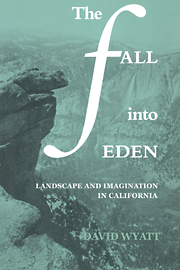Book contents
- Frontmatter
- Contents
- List of illustrations
- Acknowledgments
- Prologue: The mythology of the region
- 1 Spectatorship and abandonment: Dana, Leonard, and Frémont
- 2 Muir and the possession of landscape
- 3 King and catastrophe
- 4 Mary Austin: nature and nurturance
- 5 Norris and the vertical
- 6 Steinbeck's lost gardens
- 7 Chandler, marriage, and “the Great Wrong Place”
- 8 Jeffers, Snyder, and the ended world
- Epilogue: Fictions of space
- Notes
- Bibliography
- Index
4 - Mary Austin: nature and nurturance
Published online by Cambridge University Press: 18 December 2009
- Frontmatter
- Contents
- List of illustrations
- Acknowledgments
- Prologue: The mythology of the region
- 1 Spectatorship and abandonment: Dana, Leonard, and Frémont
- 2 Muir and the possession of landscape
- 3 King and catastrophe
- 4 Mary Austin: nature and nurturance
- 5 Norris and the vertical
- 6 Steinbeck's lost gardens
- 7 Chandler, marriage, and “the Great Wrong Place”
- 8 Jeffers, Snyder, and the ended world
- Epilogue: Fictions of space
- Notes
- Bibliography
- Index
Summary
the eagle and the trout
Austin's (1868–1934) landscapes are charged with the drama of care. It is summer in Inyo, and a cloudburst has just blown through the canyon:
Mary went out with the baby on one arm and a hoe on the other to look for what it had left, a very large and lively lake trout thrashing indignantly in a transient pool. Mary laid the baby under a sagebush while she dammed the shallow trickle below it before undertaking to flip the trout out with the hoe. At that instant an eagle hovering, who must have already marked it for his own, swooped and snatched. Mary struck him with the hoe, so that he dropped the trout, which Mary fell upon; the eagle sharply with a resentful scream darted for the sleeping child. Mary sweats still to think what might have happened if she had not laid it so close up under the covering sage. Once more the hoe came into play and the eagle swooped, this time raking the raised arms with a long claw before, screaming, he made off into invisible blueness. I do not even yet recall how Mary got back to the house–with the trout; but it was days before she would so much as take the child outdoors without a preliminary survey of the wide haunt of eagles, and she left out that part when she accounted to Wallace that night for the trout at supper.
In this episode from her autobiography, Earth Horizon (1932), Austin rises to an occasion that life did not generously offer her: the chance to choose decisively for her child.
- Type
- Chapter
- Information
- The Fall into EdenLandscape and Imagination in California, pp. 67 - 95Publisher: Cambridge University PressPrint publication year: 1986

